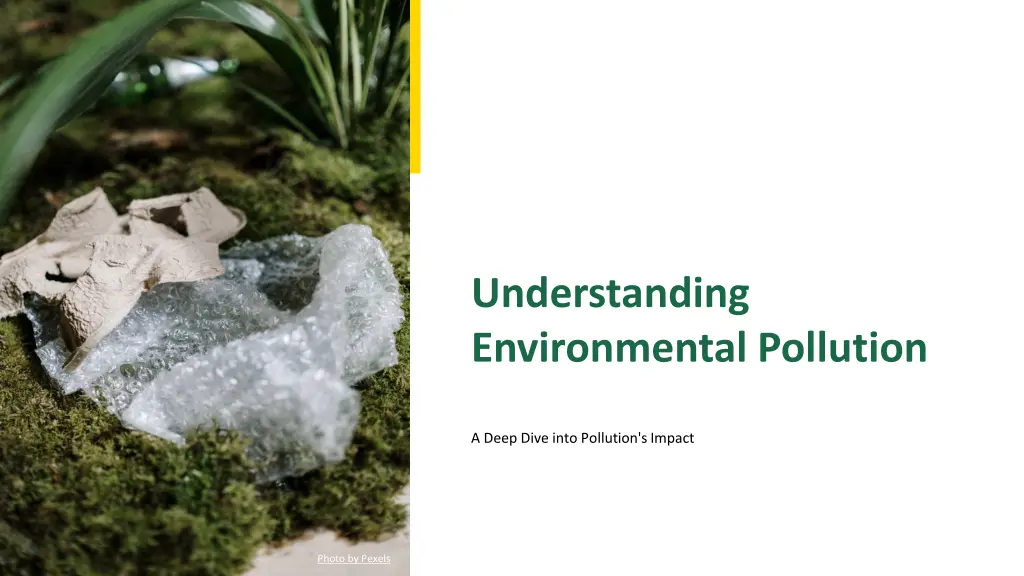
Understanding Environmental Pollution: Impact, Types, Causes, and Solutions
Explore the essence of pollution, its types, causes, and health impacts. Learn about the challenges of waste management, pollution control measures, and the role of education in combating pollution for a sustainable future. Discover the risks associated with nuclear hazards and the urgent need for collective action to address environmental pollution effectively.
Download Presentation

Please find below an Image/Link to download the presentation.
The content on the website is provided AS IS for your information and personal use only. It may not be sold, licensed, or shared on other websites without obtaining consent from the author. If you encounter any issues during the download, it is possible that the publisher has removed the file from their server.
You are allowed to download the files provided on this website for personal or commercial use, subject to the condition that they are used lawfully. All files are the property of their respective owners.
The content on the website is provided AS IS for your information and personal use only. It may not be sold, licensed, or shared on other websites without obtaining consent from the author.
E N D
Presentation Transcript
Understanding Environmental Pollution A Deep Dive into Pollution's Impact Photo by Pexels
01 The Essence of Pollution Table of Contents 02 The Types of Pollution 03 Causes of Pollution 04 Health Impacts of Pollution 05 Nuclear Hazards 06 Waste Management Challenges 07 Pollution Control Measures 08 The Role of Education 09 Moving Forward Together 10 Thank You!
1 The Essence of Pollution Understanding the Basics Pollution is a global challenge that threatens our environment and health. Understanding its essence is crucial for effective combat. The pollution we face today comes from various sources, requiring urgent attention and action. Ignoring it is not an option anymore. Identifying pollution's sources helps tackle it at the root level, ensuring cleaner air, water, and soil for future generations. Awareness and education about pollution empower individuals to make better choices and advocate for necessary changes in policies. Photo by Pexels
2 The Types of Pollution Different Forms, Different Effects Air, water, soil, and noise pollution are the primary types impacting our environment. Each type brings unique challenges. Air pollution, often unseen, affects millions daily, leading to respiratory diseases and environmental degradation. Water pollution threatens aquatic life and human health, necessitating strict control measures for preservation. Soil pollution undermines food safety and biodiversity, reminding us of our responsibility towards sustainable practices. Photo by Pexels
3 Causes of Pollution What Fuels the Crisis? Industrial emissions, vehicle exhaust, and improper waste disposal are major contributors to pollution. Understanding these is vital. Urbanization and population growth exacerbate pollution, pushing natural resources to their limits. Increased plastic usage and deforestation are silent but deadly causes, impacting ecosystems and human health alike. Addressing the root causes can pave the way for innovative solutions and sustainable development. Photo by Pexels
4 Health Impacts of Pollution The Human Cost Pollution significantly contributes to numerous health issues, including chronic diseases and respiratory problems that affect millions. Children and the elderly are particularly vulnerable, highlighting the need for urgent action to protect these groups. Long-term exposure to pollutants can lead to irreversible health effects, making preventiona priority in public health. Effective pollution control measures can drastically improve health outcomes and enhance the quality of life. Photo by Pexels
5 Nuclear Hazards Understanding the Risks Nuclear hazards pose significant risks, including radiation exposure, which can have devastating health consequences. Accidents at nuclear facilities can lead to environmental contamination, leaving long-lasting impacts on local communities. Awareness and preparedness are vital in minimizing risks associated with nuclear energy and waste. Stricter regulations and safety protocols can help mitigate the dangers of nuclear hazards in our environment. Photo by Pexels
6 Waste Management Challenges Urban and Rural Perspectives Effective waste management is crucial in combating pollution, yet many areas struggle with properdisposal methods. Urban areas often face overwhelming waste due to population density, necessitating innovative solutions like recycling. In rural communities, improper waste disposal practices lead to soil and water pollution, demanding educational initiatives. Community involvement and sustainable practices are key to managing waste effectively and protecting the environment. Photo by Pexels
7 Pollution Control Measures Towards a Cleaner Future Implementing strong regulations and policies is essential in controlling pollution and safeguarding health and environment. Promoting clean technologies and sustainable practices can lead to significant reductions in pollution levels. Public awareness campaigns play a crucial role in encouraging responsible behaviors and community action. Global cooperation is necessary to address pollution on a larger scale, promoting a healthier planet for all. Photo by Pexels
8 The Role of Education Empowering Change Education is key in raising awareness about pollution and its effects, driving community initiatives for change. Empowering individuals with knowledge enables them to advocate for sustainable practices in their daily lives. Educational institutions play a pivotal role in shaping future leaders who prioritize environmental health and sustainability. Investing in education can create a more informed society ready to tackle pollution and its challenges. Photo by Pexels
9 Moving Forward Together Collective Responsibility Pollution is a shared challenge that requires collective action from individuals, communities, and governments alike. By working together, we can implement sustainable solutions that benefitboth the environment and public health. Collaboration across different sectors enhances the effectiveness of pollution control measures and initiatives. Each one of us has a role to play in creating a cleaner and healthier environmentfor future generations. Photo by Pexels
10 Thank You! Together for Change Thank you for your interest in understanding environmental pollution and its effects. Together, we can create a cleaner world. Your actions matter; whether big or small, each step contributes to a healthier environmentfor all. Let s continue to educate ourselves and others about pollution and strive for sustainable practices in our lives. Together, we can make a difference and promote positive change for a better future. Photo by Pexels
